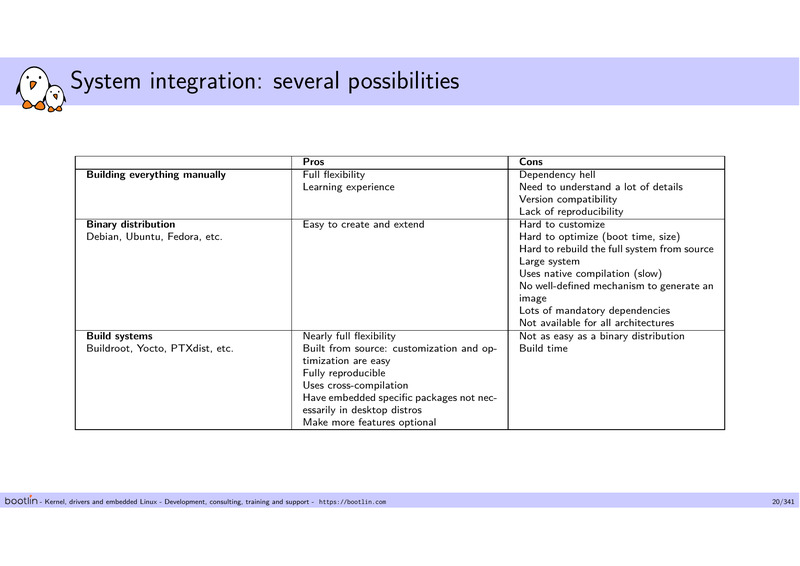2020-06-21 afbjorklund
Buildroot Kubernetes
Buildroot is a simple, efficient and easy-to-use tool to generate embedded Linux systems through cross-compilation.
It comes with very nice documentation, and is updated in yearly Long Term Support (LTS) releases (latest being 2020.02.x).
Used for minikube.iso
Several possibilities
When integrating a system, there are several possibilities:
Building everything manually
Binary distribution
Build systems
There are pros and cons of each, as described nicely here:
Taken from the Buildroot documentation which is: (c) Copyright 2004-2020, Bootlin
https://bootlin.com/training/buildroot/
Distribution
The boot2podman integration is a mix of manual build and binary distribution:
- Tiny Core Linux http://tinycorelinux.net/
- Container kernel and packages
Many of the packages are custom-made from source, in Linux From Scratch fashion.
Compared to something like hypriot, which is a more of a traditional distribution:
- Raspbian (Debian) http://raspbian.org/
- Container kernel and packages
But using a build system like Buildroot integrates the best of both of the other two.
You get high-level packaging and code re-use by using simple make based system.
And you also get host tools and cross-compilation, instead of having to use target.
The major down side is that there is no runtime package manager, only buildtime.
Kubernetes
Building on boot2docker, adding systemd and kubeadm into buildroot4kubernetes.
We still need the kernel container support (namespaces, cgroups, overlayfs). But now also some advanced networking support (nat, bridge, conntrack, vxlan).
The simple init system is replaced with the more complex systemd platform.
There are still the docker programs (dockerd, containerd, docker). But now also with the kubernetes programs (kubeadm, kubelet, kubectl).
https://github.com/afbjorklund/buildroot4kubernetes
There are two major configuration files used:
-
buildroot_defconfig -
kernel_defconfig
Both using the Kconfig configuration system, originally from the Kernel Build System.
This produces two things as the build output:
-
Linux kernel image
-
Root file system
These two files then get bundled into a bootable CD image or a flashable SD image, depending on the platform.
X86
amd64(x86_64)
For running with QEMU/KVM and other hypervisors:
126M output/buildroot.iso
ARM
arm64(aarch64)
For flashing for Raspberry Pi 3 and later models:
127M output/sdcard.img.zip
cri-o
It would be possible to do an image version replacing docker with podman and containerd with cri-o, ibut using the same kernel and other packages.
k3s
The actual Kubernetes (k8s) installation is done using container images, making this installation around three times bigger total than using k3s.
Others
The reference installation, based on Ubuntu and the official Google packages, can be found for instance here. Using Vagrant and Ansible, for simplicity.
https://github.com/afbjorklund/vanilla-kubernetes
A supported and ready-to-run solution is available in the Minikube project. It also uses Buildroot, but has more packages added beyond the minimal.
